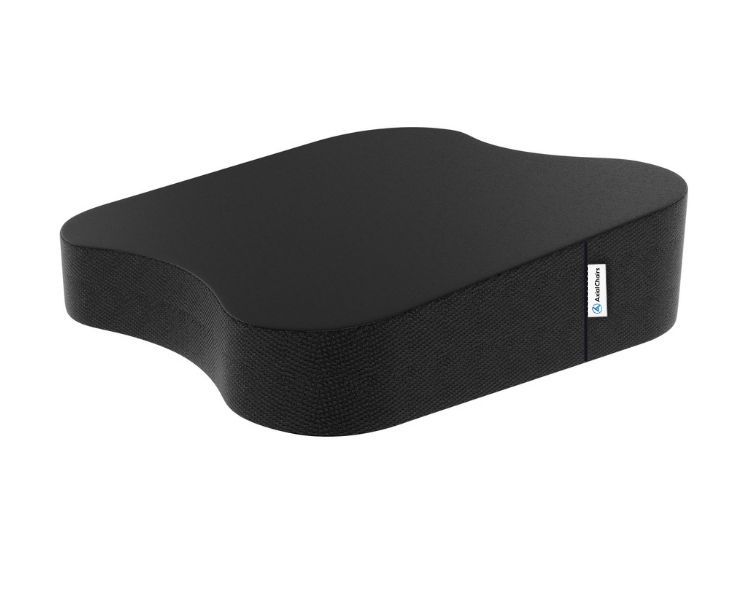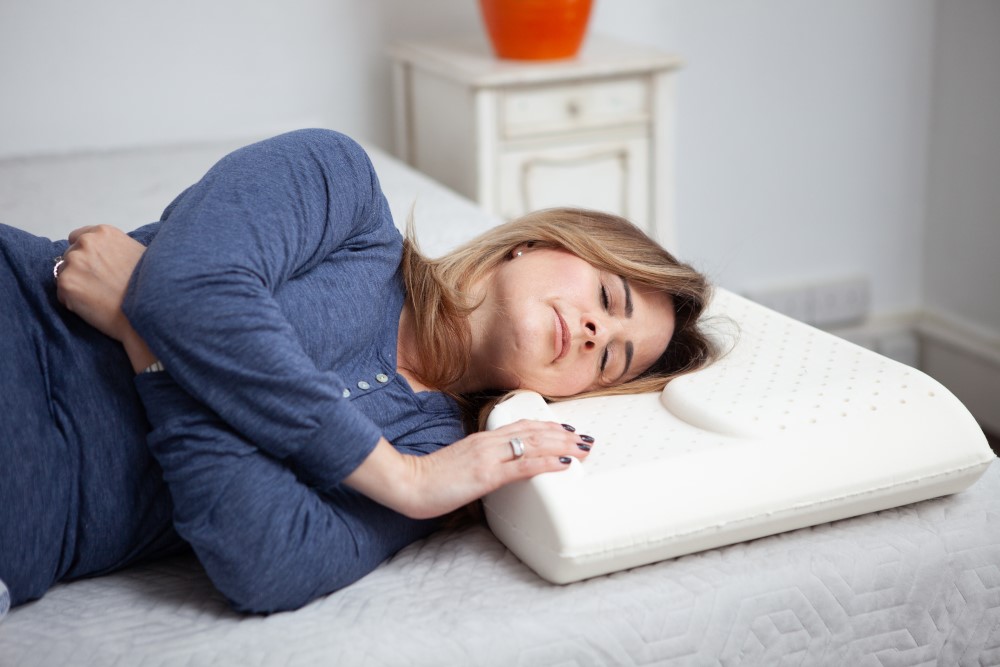As a doctor, I see many people suffering from lower back pain every day. It’s a common condition that can affect anyone, and it can be debilitating if left untreated. The good news is that simple lifestyle modifications, specifically with pillow placement while sleeping, can help to relieve or even prevent some of the discomfort associated with this type of chronic pain. In this post, I’m going to discuss different strategies for proper pillow placement in order to reduce lower back pain and improve sleep quality at night.
As a general rule, place a 10cm pillow under your knees when sleeping on your back to maintain spinal alignment; If you sleep on your side, a pillow between your knees will help; Avoid thick pillows under your head, as they can cause neck strain.
All Day Comfort & Support
How should I lay on a pillow for lower back pain?
When lying in bed with a pillow for lower back pain, it is important to look for a position that alleviates pressure from the lumbar spine. The best position for lower back pain is the fetal position, lying on your side with your knees bent and close to the chest. Additionally, placing a pillow between the knees can help reduce strain and discomfort by keeping the spine aligned.
Where should a pillow be placed for back pain?
For those dealing with back pain, it is recommended to use multiple pillows as support. Placing one pillow behind the head and neck can provide extra comfort, while another should be placed underneath either the knees or lower abdomen to support proper spinal alignment during sleep.
Should I put a pillow under my lower back for pain?
Yes! While sleeping on one’s side with knees bent is often recommended for those suffering from chronic low back pain, adding an additional pillow beneath the lower back can help increase comfort by reducing strain on both your hips and spine. It is important to note that using too firm of a pillow may cause more discomfort than relief, so it may be worth investing in a body pillow designed specifically for this type of support.
I’ve written a complete hands-on review about the best sitting position for sciatica, and here is what I tested best with my sciatica patients.
Black Friday: 35% Off Today
Typical Delivery 1-3 Days
What is the best position for lower back pain?
The best position for those suffering from chronic lower back pain is sleeping in the fetal position – that is, lying on one’s side with knees bent and close to the chest – as this provides optimal support and encourages proper spinal alignment throughout sleep. Pillows can also be used in this position; placing one between your legs helps keep them at an even distance apart while also providing more cushioning along each side of your spine.
How Pillows Can Help Relieve Lower Back Pain?
Pillow placement plays an essential role in reducing lower back pain during sleep – whether it’s through encouraging proper posture or providing extra cushioning around certain areas of the body. For instance, adding extra pillows can help alleviate pressure off sore joints due to arthritis or other conditions. Additionally, pillows are particularly useful when trying to reduce pressure points around areas such as the neck shoulders or hips since they promote equal distribution of weight throughout these areas when used correctly (i.e., positioning them appropriately). Furthermore, using multiple pillows instead of just one can create better spinal alignment which prevents uncomfortable twisting and straining during sleep thus promoting a better restful night’s sleep overall!
I explain the concept of my ergonomic design on a TV show HERE
Pillow Placement for Low Back Pain Relief
For those suffering from chronic low back pain, finding optimal support during sleep involves careful consideration when positioning both body and pillows alike. One popular strategy among sufferers involves sleeping on their sides in what has been nicknamed ‘the fetal position.’ This involves tucking one’s legs up towards the chest while also tucking a small pillow between the legs as well as beneath the head/neck area (if needed). This helps create better tension relief by preventing any unnecessary torque force against joints like hips or knee joints which would otherwise cause more discomfort than relief if left unchecked! Additionally using two firm pillows beneath either side of one’s abdomen/lower-back area will help provide further cushioning without sacrificing too much posture alignment throughout sleep thus making sure even distribution of weight occurs all over!
All Day Comfort & Support
The Best Sleeping Position For Lower Back Pain
When considering which sleeping positions are best suited for someone suffering from chronic low back discomfort there are two main factors to consider: posture alignment & tension relief. As far as posture alignment goes – experts suggest opting for positions such as ‘the fetal’ (i.e., sleeping on one’s side with knees tucked close) which allows gravity to work in favor by naturally keeping our spines straight and taking pressure off painful joints like hips & knee-caps etc… As far as tension relief goes – having multiple firm pillows strategically placed underneath different parts of our bodies like the head-neck area or around the abdominal/lower back will provide extra cushioning without compromising good posture too much thus helping us relax into comfortable positions better!
Choosing The Right Pillow To Ease Low Back Pain
When searching for good quality pillows that offer optimum support & comfort levels while also being gentle enough on sensitive backs – look not only at general shape but material composition too! Generally speaking, natural latex foam varieties tend to be great options since they contour nicely around different parts of our bodies all while still allowing adequate air circulation! Additionally, if you’re looking for something slightly softer then down-filled types may do a better job here but bear in mind these won’t last nearly long enough compared to foams so you might need replacing sooner than expected. In short – choose wisely because the wrong choice here could potentially exacerbate existing issues rather than relieve them – so make sure to test out a few different before settling the final purchase decision.
Finding Comfort: Side Sleeping with a Pillow for Lower Back Pain
Sleeping on your side is often recommended for those with lower back pain. The fetal position, which is sleeping on your side with your knees curled up to your chest and lower body in a slightly tilted position can provide relief from the pressure of lying flat on your back. Placing a pillow between the knees can help reduce alignment issues in the hips and lower back. Additionally, a pillow under the arms can provide additional support while sleeping in this position. It may also be beneficial to use one or two firm pillows beneath the head and neck to keep them level with the rest of the spine and relieve any neck strain that could be causing pain.
Black Friday: 35% Off Today
Typical Delivery 1-3 Days
Benefits of the Fetal Position and Pillow Placement for Lower Back Pain
The fetal position can reduce lower back pain by keeping the balance between joints, muscles, tendons and ligaments throughout the entire body. This helps to prevent unnatural movements such as twisting or turning which can cause injury or further aggravate existing pains. Furthermore, using multiple pillows encourages proper posture which promotes good spinal alignment allowing for natural curvature to take place within the spine for optimal comfort and support. The combination of all these measures can drastically reduce lower back pain allowing for greater ease when changing position during sleep cycles.
Neck and Shoulder Support: An Essential Component of Pillow Placement for Lower Back Pain
Proper neck and shoulder support is essential when trying to alleviate lower back pain through pillows. A lumbar pillow should be used at all times while sleeping, especially while side-sleeping in order to offer extra support to areas prone to discomfort or strain such as shoulders, necks, backs and hips. Additionally placing an extra pillow behind your low back may provide some comfort too. When positioning yourself in bed it’s important not to collapse into any one area as this will only exacerbate poor posture leading to more aches and pains in the long run; instead, focus on distributing weight evenly across all areas of contact with pillows so that every part of you is appropriately supported at all times during sleep cycles.
How Multiple Pillows Can Help Alleviate Lower Back Pain
Using multiple pillows strategically placed around various parts of your body when sleeping provides extra cushioning for sore spots like backs, necks or shoulders which relieves pressure from painful areas allowing blood flow to increase, muscle tension release and inflammation to decrease all resulting in better sleep quality overall due to less disruption from minor aches or pains throughout the night. Additionally using firm pillows placed correctly could help achieve optimal spine alignment throughout slumbering hours helping prevent stiffness when waking up each morning as well as increasing comfort levels when transitioning from one sleep posture into another thus reducing fatigue associated with constantly readjusting oneself while trying to get comfortable during restful hours.
Best Seat Cushion for Back SupportAxial Ergonomic Seat Cushion® | Seat Chair Wedge
Quick Guide: A 30-Second Summary

All Day Comfort & Support
Product Name
Axial Designs™ Seat Cushion
Price
$149
Warranty
1 Year
Type
Posture Wedge
Top Layer
100% Natural Latex (Molded)
Bottom Layer
High-Density Foam
Top Material
Isometric Grippy Vegan Leather
Bottom Material
Non-Slip Material
Side Material
3D Breathable Fabric
Back Pain Causes
The number of people affected by back pain worldwide is millions. I’ve learned that there are two main types of back pain – acute and chronic. Acute back pain usually lasts between a few days and several weeks before subsiding, while chronic back pain continues for over a year.
There are many causes of back pain in the lower back, including:
- congenital skeletal abnormalities such as scoliosis, lordosis, and kyphosis
- degenerative conditions like arthritis, spondylosis, and disc degeneration.
- Other potential causes of low back pain include spinal problems like sciatica, ruptured discs, spinal stenosis, spondylolisthesis, and osteoporosis.
- Additionally, conditions like piriformis syndrome, fibromyalgia, endometriosis, pregnancy, and tumors can also contribute to back pain.
The risk of developing back pain can also be increased by lifestyle factors. A prolonged sitting period, especially with inadequate back support, increases the risk of developing back pain in overweight and elderly individuals, as well as those who have poor posture or lead sedentary lifestyles. Depression, anxiety, and stress can also increase the risk of back pain.
As a chiropractor, I recommend maintaining regular movement and exercise, as well as using proper seat cushions to reduce back pain. Getting enough quality sleep is also important for maintaining a healthy back; In order to minimize the risk of developing back pain and maintain a healthy back, individuals can maintain a good sitting posture during the day and a proper sleeping position at night.
Back Pain Warning Signs
Back pain can sometimes be relieved through self-care, but medical professionals may need to intervene in some cases. Prompt medical attention is necessary when specific warning signs are present, such as a fever with pain, numbness in the groin area, sudden leg weakness, loss of bladder or bowel control, inability to find a comfortable sitting or standing position, or an escalation in pain instead of relief.
Summary
Taking the time to find a pillow arrangement best suited for the way you sleep can be incredibly beneficial in promoting better spine health. Remember to use pillows judiciously―you don’t want your bed turning into a mountain of foam! That being said, take care to make sure that no matter your sleeping position, your back and neck are properly supported. Your spinal health is invaluable, so don’t let a good night’s rest compromise it. In any case, it’s always better to err on the side of caution and invest in high-quality pillows. Pay attention to how you feel when sleeping; if something doesn’t feel right, don’t hesitate to change positions or switch up your pillow setup. Finally, make sure to give yourself plenty of time for adequate rest and relaxation: it’ll help you stay energized for all the tasks ahead!





